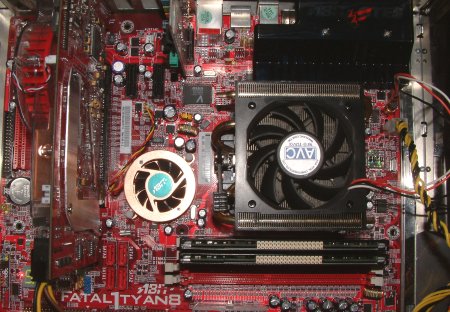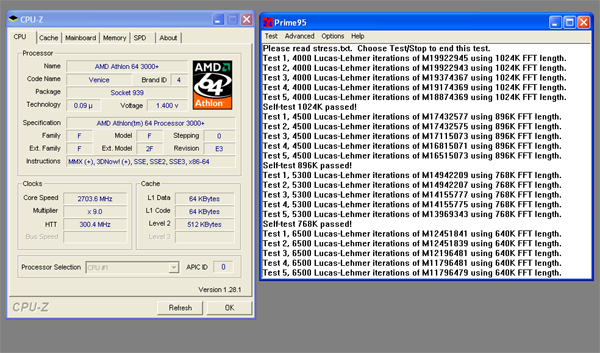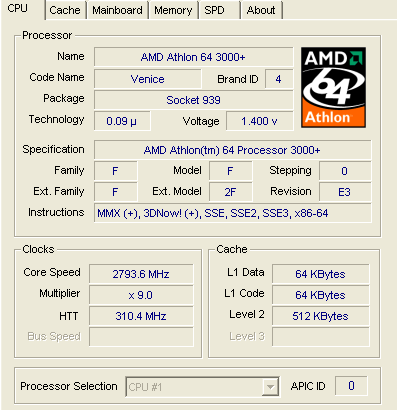Tools of the trade
Tools of the tradeOverclocking non-FX AMD Athlon 64s boils down to raising the external clock speed to the highest stable limit, as the multiplier is locked (upwards, at least). What you need, therefore, is a motherboard with bus-locking support and a wide array of voltages to play with. Thinking of S939 chipsets in general, NVIDIA's nForce4 has shown considerable HTT overclocking potential. We've tested a few here at HEXUS and the best of the bunch, by a clear margin, has been ABIT's Fatal1ty AN8 mainboard. Testing showed it to be stable at 320MHz HTT speed, accomplished without additional cooling. This is the kind of partner an E3 revision CPU needs, especially one with a 9x default multiplier.
There's two choices when evaluating which system RAM to go with. You can go down the synchronous route, that is, keep system memory ticking along at the same speed as the external clock bus. The problem, however, is one of keeping up with the CPU. If, for example, it can hit 300MHz HTT one needs DDR1-600+ RAM. It's possible, sure, but not so easy to come by. The other method is to use the mainboard's BIOS to set lower DRAM frequencies at high HTT speeds. That way, you can still keep low latencies for ultra-quick transfers. For this overclocking experiment I chose to go with Corsair's Xpert XMS3200XL low-latency memory and run it at its native 2-2-2-5 timings.
An often-overlooked part of overclocking is power delivery. A top-quality PSU can gain you stability at higher frequencies than a generic model, I chose OCZ' PowerStream 520w model. It's got 33A on the critical 12v line, adjustable power rails, and is as quiet as the proverbial church mouse.
I also opted to use a reference AMD Athlon 64 FX-5x heatpipe-driven cooler. The idea of this test is to see how high the sample would clock to without the use of esoteric cooling.

An ATI RADEON X850 XT PE 256MB card provides enough gaming power to put the onus on the subsystem.
Overclocking notes
External clock (HTT link) overclocking was undertaken by dropping the HT frequency to 3x, dropping the DRAM speed to DDR266, raising the nForce4 Ultra's chipset from the default 1.5v to 1.65v, and then raising the external clock speed in increments of 10MHz until system instability set in.
ABIT's Fatal1ty AN8 has a strong VCore line under load. Inputting 1.4v in BIOS resulted in a Windows XP load voltage of around 1.45v. This was deemed stock voltage for the Venice core Athlon 64 3000+, although it's around 5% higher than other boards with the same setting. 220MHz external clock came and went, 250MHz breezed by, 275MHz (2475MHz overall clock speed) was effortlessly stable. The magical 300MHz external clock speed was also stable as stock speeds, as confirmed by Prime95's torture test.

Instability set in at around 2740MHz. CPU Vcore was raised to 1.5v in BIOS (1.54v under load) and a final, rock-stable clock speed of 2793.6MHz was reached, as shown below.

Now this isn't some one-off benchmark speed. It's one that I'd be comfortable in using day in, day out. It's very nearly a 1GHz overclock from the default 1808MHz and represents an overclock of almost 55%, all accomplished with a retail PIB cooler and wise choices in supporting equipment. It's also a higher clock speed than the £550 Athlon 64 FX-55, which runs at 2600MHz but does feature 1MB L2 cache. No matter which way you look at it, a ~£100 CPU capable of besting, in MHz terms at least, the fastest current Athlon 64 can be no bad thing. DRAM frequency was set to a maximum DDR266 limit at 200MHz external clock speeds, which translated into DRAM running at DDR399 @ 310MHz external clock.
2.8 Gigawiggles ought to be mighty fast in our benchmark suite, so let's stack both the stock and overclocked Athlon 64 3000+ Venice CPU up against some healthy and expensive competition.









